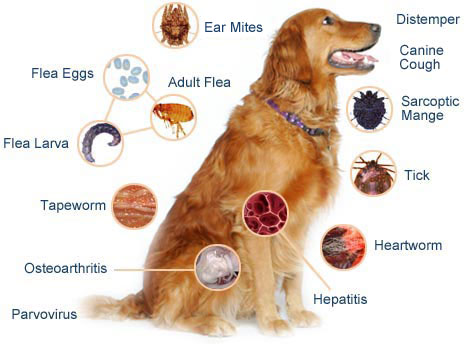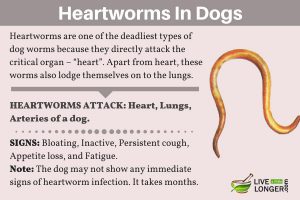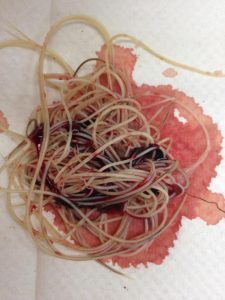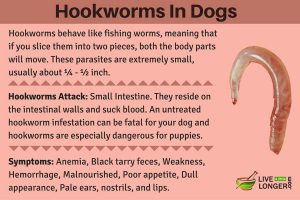Getting Familiar With Dog Parasites

Many pet parents like to take their pets out for walks, have them play outside and when they do, your pet may encounter some parasites. Becoming familiar with the symptoms can also help. Some of these common dog parasites are internal and some are external. It’s important to know that you cannot keep these parasites completely from your pet. However, you can control their impact on his health with regular medication prevention.
Internal parasites are those that affect the intestines, organs and other internal areas of the pets body.
External parasites are those that affect the outside of the dog’s body. The most common areas are the hair, skin, ears, paws, nails, and belly area.
Some dog parasites are more harmful than others. It’s important to know the common dog diseases that pets may experience during their lifetime. Knowing about these parasites can help you to take the appropriate action for prevention instead of treatment which can be expensive if left untreated.
Below is a list of the most common pet parasites.

Internal Parasites
Below are some of the most common internal parasites that your pet may encounter throughout their lifetime. The information in parenthesis are the areas these parasites infect or attack.
- Heartworm (Organs – Heart & Lungs)
- Hookworms (Intestinal)
- Ringworms (Intestinal)
- Roundworms (Intestinal)
- Tapeworms (Intestinal)
- Whipworms (Intestinal)
- Coccidia (Non-Worm Parasite Intestinal)
- Giardia (Non-Worm Parasite Intestinal)
- Spirochetes (Non-Worm Parasite Intestinal)
External Parasites
Below are some of the most common external parasites that dog’s will encounter. Some of these diseases if left untreated can lead to further health problems.
- Fleas
- Lice
- Mites
- Ticks
It is impossible for your dog to avoid all of the above parasites. As pet parents you can help your pet by controlling most of them through prevention. You can probably talk with your vet to inform you which of the above parasites are most active or prevalent in your area and at what months or seasons of the year. Then purchase the medication that treats more than one of them using the same dose.
Identifying Internal Parasites
With so many parasites that affect the dogs with the same symptoms, below is an explanation on each of them in greater detail.
Heartworms

Heartworms is a disease known as dirofilariasis and is a serious and potentially fatal disease that can cause death if left untreated. Once a dog is bitten by an infected mosquito, the larvae eventually mature into adult heartworms. They can grow up to twelve inches in length and can live from 5 to 7 years. The average dog can have up to 250 worms in his body. It can take up to six months before your pet will actually show signs of the heartworm infection.

Basically heartworms enter a dog’s bloodstream from the bite of an infected mosquito. These worms mature in the dog’s heart and sometimes in the lungs and can grow up to one foot in length and clog the heart. Inflammation in the dog’s arterial wall disrupts blood flow, makes the heart work harder.
Once blood flow slows sufficiently, a heartworm-infested dog develops a mild, persistent cough, becomes fatigued after a mild exercise, and a reduced appetite. In some cases may even die of heart failure if the disease is left untreated.
Hookworms

Hookworms in dogs, scientifically known as “Ancylostoma caninum” or “Ancylostoma braziliense,” are intestinal parasites that literally hook themselves into the lining of your dog’s intestines.
These worms live in the dog’s digestive system, and are acquired either by puppies from their mother when nursing or by adult dogs swallowing the parasite’s eggs, or having the hookworm burrow into the skin. The eggs are ejected into the digestive tract and pass into the environment through the dog’s feces. The hookworm larvae live in soil, and can be ingested when the dog comes in contact via eating them or through self-cleaning. It attaches to the lining of the intestinal wall, and feeds on the dog’s blood. The result is blood loss that can have serious effects, especially in puppies.
Currently there are no vaccines that vets can use to treat hookworms. It is only treated through medication that the vet will prescribe. You can also use over-the-counter medications found in your local pet store to treat this disease.
Ringworms
Dermatophytos is is the medical term for the fungal infection affecting the skin, hair, and/or nails (claws) that is more commonly referred to as ringworm.
This is actually a fungus and not a worm. Puppies less than a year old are most susceptible to ringworm because of their still-developing immune system. Also, adult dogs who are malnourished or stressed, or immune system is diminished, are at risk of ringworm. An infected dog will develop lesions on their head, ears, paws, or forelimbs. These lesions cause circular bald spots which can look red in the center. In mild cases, some dogs suffer only a few broken hairs. In severe cases, the infection can spread over their entire body.
Ringworm fungus can also be spread through contaminated objects like bedding, brushes, clippers, and cages. Some species of ringworm live in the soil, and dogs can become sick after contacting dirt that is home to these organisms.
Some dogs can be a silent carrier of this disease. This means that they harbor the fungus but have no visible signs of the condition and can pass it on to other dogs.
Roundworms
Ascariasis is a disease affecting dogs caused by the intestinal parasitic roundworm (or Ascaris lumbricoides). Roundworms are often quite large — up to 10 to 12 centimeters in length.
Roundworms are the most common of the parasitic worms found inside a dog. Almost all dogs become infected with them at some time in their lives, usually as puppies.
They look like white, firm, rounded strips of spaghetti, one to three inches long. Veterinarians look for signs in the pets stool sample. The symptoms are coughing, vomiting, diarrhea, or malnourishment. Roundworms can infect children and other dogs.
Puppies are at risk due to contacting the parasite during the pregnancy and by drinking the milk from an infected pregnant animal. If any of the newborn puppies should get exposed to roundworms, the parasite can affect the entire litter.
Adult dogs can become infected through the ingestion of roundworm eggs, which are found in infected food, water, vomit, or feces.
Tapeworms
Tapeworms are long, flat worms that attach themselves to your dog’s intestines.
A tapeworm is ingested by your dog via a host that is harboring a tapeworm egg. This is usually by an adult flea. Some signs of this parasite is loss of weight, and occasional diarrhea. You will know your pet has them as you will see segments of the worms around his anus or in their stool. The segments look like grains of rice or seeds. The best prevention is to keep your pet away from dead animals, garbage, and free of fleas.
You can prevent fleas from your dog by using over-the-counter flea control treatment medication found in the pet store.
Whipworms
Dogs acquire whipworms by licking or sniffing contaminated ground. The adult whipworm is about 1/3-inch long and resembles a very small piece of thread. They reside in the dog’s large intestine, but unlike other parasitic worms are difficult to spot in the stool sample. This type of parasite can only be treated by using a dewormer. There are many dewormers found in the pet store that treat and prevent whipworms.
The best prevention of this disease is to clean the yard whenever your pet goes out and does his business.
In most cases, your dog may not show any signs of this disease. As it is untreated they may show signs of bloody diarrhea. If the infection is not treated, your pet can cause serious health issues and even death.
Coccidia
Coccidia are single-celled and found in puppies where they acquire it through their litter mates or the mother. These organisms live in the wall of the dog’s intestine. Dogs become infected by swallowing soil that contains coccidian or other substances in the environment that may contain dog feces.
The most common sign of coccidiosis is diarrhea. In some cases, severe infections can cause bloody diarrhea. If left untreated severe infections, especially in puppies, can kill them.
The best prevention of this disease is to clean the yard of your pet’s feces when they go to the bathroom. Also, since this disease is prevalent in puppies, have him examined by your vet to determine if he has the parasite.
This infection or disease cannot be passed on to humans.
Giardia
Giardia is a single-celled parasite that lives in your dog’s intestine. It infects older dogs but more frequently infects puppies.
Pets get this parasite from infected soil, water, feces, food, and other animals. Generally the dog swallows the cyst stage of the parasite. It takes about 5 to 12 days to fully be infectious in dogs. If sufficient numbers are present, signs of damage to the intestinal wall will develop.
The best way to prevent this disease is to ensure you provide your dog with fresh drinking water. Do not let your pet drink water where other pets left their feces.
This disease is not spread from dogs to humans.
Spirochetes
Spirochetes are spiral, or corkscrew-shaped bacteria which infiltrate the system by burrowing into the skin and spread through the body by way of the bloodstream. Live in the dog’s intestinal tract. Dogs come into contact with this parasite in infected water, soil, mud, while swimming, drinking contaminated water, or coming into contact with urine from an infected animal. This parasite is very dangerous because they can infect a dog before he actually appears sick.
You must wear protective latex gloves at all times because all body fluids will be treated as biologically hazardous material. Urine, seamen, post-abortion discharge, vomit, and any fluid that leaves the body will need to be handled with extreme caution.
Identifying External Parasites
We will be describing some of the most common external parasites dogs will experience on their bodies.
Fleas
Fleas are the most common external parasite found on dogs. These are tiny wingless insects that feed on mammals which also includes dogs. Fleabites make dogs miserable that they bite and scratch themselves to the point of exposed skin or rawness. If you notice fleas on your dog get rid of them quickly as possible before the population grows. Fleas also bite humans leaving small, red, itchy bumps seen on the wrists and ankles.
You might be able to see the flea dirt in your pet’s hair cost. The fleas are the size of sesame seeds that are scurrying around the skin. The best places to spot them is the base of the ears, and the rump. You can get over the counter medication to curb these parasites on your dog.
Ticks
Ectoparasites are organisms that live on the outside of an animal. All dogs can get ticks even if they spend most of their time indoors any only limited time outdoors.
Ticks attach themselves to your pet by inserting their mouthpiece into your dog’s skin. Some ticks can produce a sticky, glue like substance that keeps them attached to your dog. At this point, they begin feeding on your pet’s blood. These areas where ticks attach themselves becomes red and irritated.
This parasite can cause a number of serious illnesses which include Lyme disease, Ehrlichiosis, anemia, and Rocky Mountain Spotted Fever. Dogs get ticks when they spend any time outside. So, it’s important to check the dog for ticks and if you should see one to remove it immediately.
It is virtually impossible for you to prevent your dog from getting ticks. You can help by using tick control products from your local pet store or vet.
Lice
These are microscopic organisms that feed on your dog’s skin and can cause the following:
- Itching
- Hair Loss
- Infection
There are two types of lice that can infect dogs: Trichodectes canis which chews the skin of the dog. Linognathus setosus which sucks the blood of the dog instead of chewing the skin. If left unchecked, they can grow to be an infestation on the dog’s body. Lice are often seen in areas where sanitary practices are poor.
Mites
These are crab-like parasites that live on and inside of the skin, pores, hair follicles and hair coats of dogs. They are so small that they cannot be seen with the naked eye. There are five types of mites that affect dogs and they are:
- Sarcoptes scabiei (burrowing mites)
- Demodex canis (demodex mites)
- Cheyletiella yasguri (surface mites)
- Otodectes cyanosis (ear mites)
- Pneumonyssoides caninium (nasal mites)
If your pet has a mite infestation this is called mange. (https://en.wikipedia.org/wiki/Mange)
Because these parasites are so small the only way you can detect them is when pet owners see effects of them when they see their dogs scratching, licking, chew, bite, and rub at the infested areas.
An infestation of this parasite produces brownish ear wax, similar in appearance to coffee grounds. Ear mites are contagious and can travel from the ears of an infected dog to any other dogs in close contact. This also includes sleeping and playing together. This is a contagious disease all pets in the house should be treated for ear mites.
Conclusion
Hopefully you have learned a lot more about the parasites that can cause damage to your dog. You as the pet owner must be aware of these parasites so you can take preventive actions.